Model Village and our MPs'
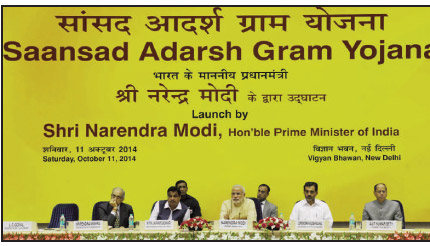 How come mos t of our
people's representatives are
unable to sus tain thei r
interest in the development
of villages they represent? I
am raising this issue in the
wake of a recent report which says that as many
as 475 out of 543 Lok Sabha MPs have not even
cared to identif y the village they would develop under Phase- III of the Sansad Adarsh Gram
Yojna (SAGY) launched by Prime
Minister Narendra Modi amidst
great fanfare in 2014.
How come mos t of our
people's representatives are
unable to sus tain thei r
interest in the development
of villages they represent? I
am raising this issue in the
wake of a recent report which says that as many
as 475 out of 543 Lok Sabha MPs have not even
cared to identif y the village they would develop under Phase- III of the Sansad Adarsh Gram
Yojna (SAGY) launched by Prime
Minister Narendra Modi amidst
great fanfare in 2014.
The Hon'ble Prime Minister ought to realise that misplaced thoughts
could become counter-productive in the long run. Every development
scheme and initiative for reforms needs to be in tune with ground
realities. Also, it needs to be appreciated that we cannot have a uniform
approach to development tasks in a country of diversity like ours. The
face of India changes after every 25 or 30 districts.
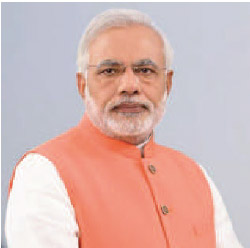 Narendra Modi
Under Phase-1 of the scheme,
each MP from the two Houses of
Parl iament i s supposed to
identif y a gram panchayat in his
cons t i tuenc y wi th a view to
turning it into a model village of
development by 2016. Two more
gram panchayat s – three in all –
would acqui re Model Vi l lage
de velopment s tamps by 2019.
This is surely a laudable scheme
by the Pr ime Mini s ter which
could keep the MPs grounded to the soil for
all-round growth at the grassroots.
Narendra Modi
Under Phase-1 of the scheme,
each MP from the two Houses of
Parl iament i s supposed to
identif y a gram panchayat in his
cons t i tuenc y wi th a view to
turning it into a model village of
development by 2016. Two more
gram panchayat s – three in all –
would acqui re Model Vi l lage
de velopment s tamps by 2019.
This is surely a laudable scheme
by the Pr ime Mini s ter which
could keep the MPs grounded to the soil for
all-round growth at the grassroots.
It all started of f very well, to begin with. As
many as 500 Lok Sabha MPs and 203 Rajya
Sabha MPs identif ied villages in the f irst year
of the launch of the SAGY scheme. In Phase II,
234 Lok Sabha members and 136 of 243 upper
House members failed to identif y villages . For
the latest Phase – III, 90 per cent of MPs are
yet to adopt a village while the time is running
out fas t for the 2019 deadl ine. Does thi s
waning interest among MPs suggest some inbuilt
f laws in the scheme? Or, have MPs found
the proposition to be time-consuming and not
lucrative enough, politically and otherwise?
No doubt , the scheme suf fers from some
serious f laws . In the f irst place, it does not
provide for a separate budget since it seeks
convergence of var ious schemes and
programmes already in vogue.
Second, parl iamentar ians , especial ly f rom
the Lok Sabha, feel that picking up one village in the cons t i tuenc y could create adver se
reaction in other villages under
their domain, to their pol i t ical
di sadvantage. Thi s i s
understandable.
Third, the MPs have to focus on
micro-level monitoring work in
gram panchayat s – the job which
comes under the jurisdiction of
MLAs . This could unnecessarily
generate conf l ict s of interes t ,
especially if parliamentarians and
legislators happen to belong to
two dif ferent political outf its .
The SAGY is typical of Modi's
de velopment mant ra which i s
hur r iedly conceived wi thout giving due
weightage to the ground realities . This was seen in the case of Demonetisation as well as
GST. Both the schemes were ful l of f laws ,
operationally and otherwise.
The government is expected to be a "prime mover" in the development
process. But in a vibrant democracy like ours, it cannot blindly or
instantly transplant one Model or the other. Our "development strategy"
has to be tailored to the actual conditions prevailing in our villages.
The Hon'ble Prime Minister ought to realise
that mi splaced thought s could become
counter-product ive in the long run. Ever y
development scheme and initiative for reforms
needs to be in tune with ground realities . Also,
it needs to be appreciated that we cannot have
a uniform approach to development tasks in a
country of diversity like ours . The face of India
changes af ter every 25 or 30 districts .
The only answer to this onerous challenge is
decent ral izat ion of pol ic y and planning .
Equal ly crucial for rural de velopment i s
empowerment of the panchayat s , both
f inancially and functionally.
The moni tor ing work of de velopment i s
general ly done by the di s t r ict- le vel -
admini s t rat ion. MPs and MLAs could be
associated with it for a six-monthly or yearly
review for re-f ixing of priorities , depending on
changing demands and expectat ions of the
villagers concerned.
What is needed in today's complexities is
depoliticisation of the development process .
Development tasks must not be seen through
political or sectarian angularities .
Development demands empowerment of the
people, educationally, health-wise as well as in
meet ing thei r bas ic neces s i t ies of l i fe and
inf rastructural connect ivi ty between Bharat
and India.
As it is , the overal l development in the
countr y is far from f lattering. I do not wish
to talk of big projects or schemes which have
their own tales of f laws . What disturbs me is
the lates t repor t f rom the Washingtonbased
International Food Pol icy Research
Ins t i tute ( IRPRI ) 's 2017 Global Hunger
Research Index (GHI) , in which India ranks
100 among 119 count r ies s tudied. The
countr y's rank, in fact , has fal len by three
places compared to 2016. Signi f icantly, in
the 2017 Hunger Index, India fal ls behind
even war-ravaged Iraq and North Korea. The
only consolation that could be derived by
of f icial s i s that in As ia , Paki s tan and Afghanistan are below the ranking of India!
A number of global and Indian studies have
talked about the suf ferings of the common men
on var ious count s l ike nutr i t ion and chi ld
mortality, awfully poor standards of primary
and secondary schooling, lopsided growth and
the prevai l ing i l l i terac y. These harsh fact s
show how precarious the country's social and
human conditions are.
True, major changes relat ing to human
af fairs , including in education, public health
and inf ras t ructure development , cannot be
brought about overnight by the Modi
government . All the same, decades of failure
demand changes in pol icies , strategies and
prioritization of the very concept of Vikas.
Development tasks must be in tune wi th
grassroots realities in villages . Here, areas of
f laws have to be identif ied afresh and new
plans of action evolved and operationalised on
a war-footing basis .
Indeed, the real challenge before the Niti
Ayog planners and leaders is to ensure that the
poor get a reasonable share in the "human
resource and economic cake" through new
avenues of growth and development . This is
possible if the rulers at the helm adopt the
required correctives urgently to rid the Indian
society of the imbalances that make the poor
poorer and the rich richer.
The government is expected to be a "prime
mover " in the development process . But in a
vibrant democracy like ours , it cannot blindly
or instantly transplant one Model or the other.
Our "development strategy" has to be tailored
to the actual condi t ions pre vai l ing in our
villages .
I hope the Prime Minister would think along
new lines . He needs to appreciate that the
central izat ion of deci sion-making does not
improve performance on the ground. Rather, it
creates obstacles for innovations and creativity
of indigeneous talents at the grassroots .
A de veloping economy l ike our s cannot
af ford extravagance to support the whims of
politicians and the indif ferent functioning of
the bureaucracy in the name of Model Village
Development!
Rising crimes speak for
poor governance
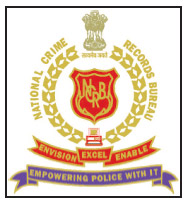 India has reasons to
be terribly
concerned about its
disquieting Social
Index. By the Social
Index, I am
specifically referring to the
rising graph of various
categories of crimes which
have both social and economic components and they
reflect on the quality of governance.
Look at any area of crime graph – rape, dowry,
domestic violence, female infanticides, trafficking in
girls, drugs and arms and petty crimes, the overall
picture is grim to the core. The 2016 data released by
the National Crime Records Bureau (NCRB) speak for
themselves.
India has reasons to
be terribly
concerned about its
disquieting Social
Index. By the Social
Index, I am
specifically referring to the
rising graph of various
categories of crimes which
have both social and economic components and they
reflect on the quality of governance.
Look at any area of crime graph – rape, dowry,
domestic violence, female infanticides, trafficking in
girls, drugs and arms and petty crimes, the overall
picture is grim to the core. The 2016 data released by
the National Crime Records Bureau (NCRB) speak for
themselves.
What is particularly disturbing is the rising graph of
crimes against women and children. There has been
82 per cent increase in incidents of rape of children
compared to 2015. The highest rise on this count has
been recorded in Uttar Pradesh, where figures have
trebled. UP recorded 400 per cent jump in child rapes.
The National Crime Records Bureau has also highlighted several
disturbing social and economic trends which must not be lost sight of.
We see a rising trend in the number of economic offences like cheating,
breach of trust, forgery and counterfeiting, illegal gains through cyber
crimes. Delhi, Mumbai and Jaipur figured prominently in these areas.
Madhya Pradesh has witnessed over a 60 per cent rise
in sexual abuses of children. The case of Maharashtra
is equally bad. In Tamil Nadu, where no case of child
rape was registered in 2015, it reported 1169 such
cases in 2016. Could this be because of the exit of
Jayalalithaa from the state's political scene on
December 5, 2016 after her prolonged illness?
The former Chief Minister was known for her
ruthless governance when it came to the safety of
women and children. She knew how to make the
police accountable for lapses in law and order issues.
The tragedy of the country since Independence has
been its poor police outfit, despite attempts at
occasional patch-work reforms. Whatever changes have been initiated for police reforms from time to
time are far from satisfactory. They hardly meet the
changing profiles of crimes in various segments of
society.
The NCRB's latest figures by themselves are
alarming. The ground realities, however, could be far
worse because of Poor Police Performance we all are
familiar with.
Nothing could be more shameful than to see 82 per
cent rise in rapes of children in 2016 from the 2015
data. Equally worrying area is the rising graph of
sexual assaults on women. The post-Nirbhaya Delhi
looks like a lost dream. Delhi reported the highest
crime rate against women – 160.4 – compared to the
national average rate of 55.2.
Crimes against women rose from 3, 23, 243, in 2015
to 3, 38, 954 in 2016. These include cruelty by
husband or relatives, followed by assault on woman
with intent to outrage her modesty, kidnapping,
abduction and rape. Among 19 metros analysed by
NCRB, Delhi, followed by Mumbai and Bengalaru
reported most number of crimes against women.
India recorded 106 rapes a day, despite several tough court rulings and tightening of laws to deal with
this menace. What a shameful commentary on the
deteriorating social environment and on the state of
the nation which boasts of its great tradition of
respect for women! This underlines one harsh reality:
there is nothing like the fear of law and law-enforcing
agencies in the country among crime-prone persons.
This prompts me to suggest that we should look
afresh at the country's crime scene and work out a
new plan of action. It must be appreciated that
everything boils down to good governance, which
includes both the tightening of laws and efficient
working of the police. There can be no short-cuts to
good governance with accountability in critical areas which remain neglected by the central and state
governments.
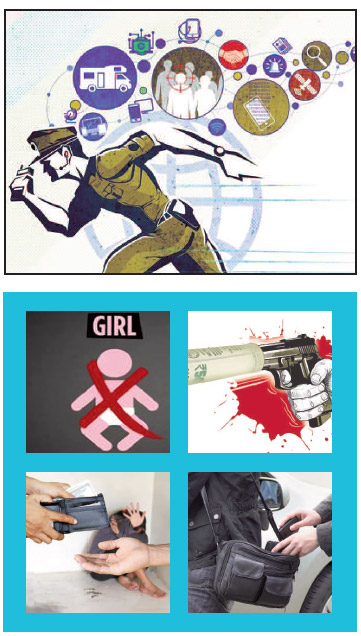 The National Crime Records Bureau has also
highlighted several disturbing social and economic
trends which must not be lost sight of. We see a rising
trend in the number of economic offences like
cheating, breach of trust, forgery and counterfeiting,
illegal gains through cyber crimes. Delhi, Mumbai and
Jaipur figured prominently in these areas.
We have also to seriously look at the agrarian
distress which led to a series of protests and riots.
The NCRB reports suggest that farmers took to
streets in large numbers demanding their rights
last year with 4,837 riots taking place across the
country. The number of riots incidents doubled in
2016 because of shrinking farm lands, failure of
crops, poor irrigation facilities, bad seeds,
drought, the rising burden of debts etc.
This agrarian crisis, again, brings me to the critical
question of governance. For one, India just does not have enough cold storage. Secondly, there is not
adequate processing of food to ensure that crops do
not perish or go waste, leading to the farmers' distress.
The National Crime Records Bureau has also
highlighted several disturbing social and economic
trends which must not be lost sight of. We see a rising
trend in the number of economic offences like
cheating, breach of trust, forgery and counterfeiting,
illegal gains through cyber crimes. Delhi, Mumbai and
Jaipur figured prominently in these areas.
We have also to seriously look at the agrarian
distress which led to a series of protests and riots.
The NCRB reports suggest that farmers took to
streets in large numbers demanding their rights
last year with 4,837 riots taking place across the
country. The number of riots incidents doubled in
2016 because of shrinking farm lands, failure of
crops, poor irrigation facilities, bad seeds,
drought, the rising burden of debts etc.
This agrarian crisis, again, brings me to the critical
question of governance. For one, India just does not have enough cold storage. Secondly, there is not
adequate processing of food to ensure that crops do
not perish or go waste, leading to the farmers' distress.
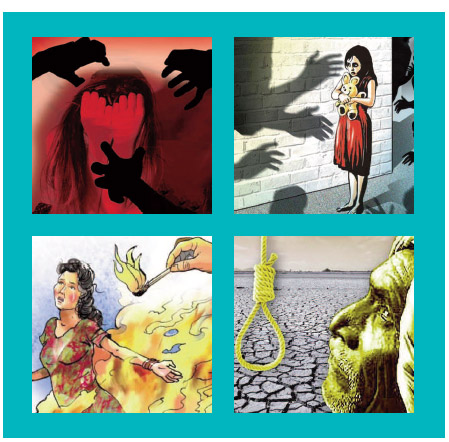 Farming policies actually need a radical overhaul in
varied areas to quell farmers' revolts. They must not
be taken for a ride, whether it is the question of loan
waivers or insurance payments! The point which I
wish to reiterate is that the rise in the crime graph is
proportionate to - rather more than proportionate – if
the governments at the Centre and in the states fail to
manage grim ground realities, whether they relate to
the safety of children, women, farmers' distress signals
or atrocities against Dalits or the scheduled castes and
scheduled tribes. The country is indeed paying a
heavy price for poor governance by the authorities
concerned in varied areas of economic and social
conflicts.
Farming policies actually need a radical overhaul in
varied areas to quell farmers' revolts. They must not
be taken for a ride, whether it is the question of loan
waivers or insurance payments! The point which I
wish to reiterate is that the rise in the crime graph is
proportionate to - rather more than proportionate – if
the governments at the Centre and in the states fail to
manage grim ground realities, whether they relate to
the safety of children, women, farmers' distress signals
or atrocities against Dalits or the scheduled castes and
scheduled tribes. The country is indeed paying a
heavy price for poor governance by the authorities
concerned in varied areas of economic and social
conflicts.
Looking beyond the 2016 NCRB data, we also
must take cow-related hate crimes seriously.
IndiaSpend's database records suggest that 97 per
cent of all such incidents have occurred since the
BJP regime came to power in May 2014. This is
highly disturbing.
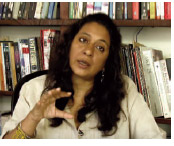 According to Meenakshi
Ganguly, South Asia director
for Human Rights watch;
"Attacks based on race,
religion, caste ethnicity in India
occur when the attackers
believe that they have political
cover and will not be prosecuted and punished".
Meenakshi is right. The ruling class must not be party
to such crimes. Such an approach would undermine
the people's faith in the justice system and the fairplay
of our leaders at the helm.
According to Meenakshi
Ganguly, South Asia director
for Human Rights watch;
"Attacks based on race,
religion, caste ethnicity in India
occur when the attackers
believe that they have political
cover and will not be prosecuted and punished".
Meenakshi is right. The ruling class must not be party
to such crimes. Such an approach would undermine
the people's faith in the justice system and the fairplay
of our leaders at the helm.





 Narendra Modi
Narendra Modi


